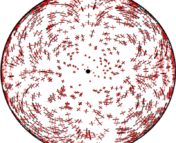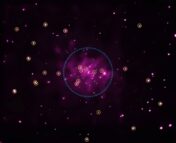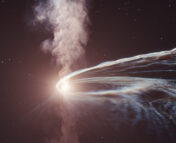Title: Close Encounters of Stars with Stellar-mass Black Hole Binaries
Authors: Taeho Ryu, Rosalba Perna, Yihan Wang
First Author’s Institution: Max Planck Institute for Astrophysics, Garching, Germany
Status: Published in MNRAS [closed access]
In 2015 LIGO and Virgo detected gravitational waves from the merger of a binary black hole (BBH) system. This discovery opened up a new way of observing the universe and sparked interest in studying the formation and evolution of binary black holes (BBHs). In dense environments such as nuclear and globular star clusters, we expect to see interactions of stars with BBHs. What happens when a single star interacts with the black hole binary? Would the black holes gobble the star up or rip it apart? Will this process result in interesting physics detectable by electromagnetic and gravitational-wave observations? These are some of the questions addressed in this study conducted by the authors.

When a star interacts with a binary black hole, energy, and angular momentum will be exchanged. To study this process in detail, the authors performed hydrodynamic simulations of close encounters between a one solar mass star and stellar-mass black hole binaries. They studied how such events would affect the binary by tracking the evolution of the system’s orbital parameters (such as eccentricity and semi-major axis). Such encounters could result in a tidal disruption event (TDE) where the star gets ripped apart by the tidal force exerted by the black holes. TDEs are very exciting as they often produce an electromagnetic signature that could be observed as a counterpart to the gravitational wave coming from the merger of the binary. The close encounters could speed up the merger of the binary black holes. Gravitational waves from stellar mass binaries are observable by LIGO and Virgo, therefore understanding how their merger time scales are affected by TDE events is necessary.
Simulating the close encounters
The authors used a hydrodynamics code called Phantom to model the interactions between the solar mass star and BBHs. A set of initial conditions for the orbital parameters of the BBH system are chosen. In the binary system we call the BH that disrupts the incoming star the disruptor and the non-disrupting BH is called the bystander. The simulations are categorized into regular debris flow and non-regular debris flow based on the trajectory of the debris stream in the TDE and its interaction with the bystander BH. In a regular debris flow (top panels of Figure 2), the star is disrupted by disruptor BH and the shape of the debris looks very similar to a regular TDE by single black holes. In a non-regular debris flow (bottom panels of Figure 2), the debris also interacts with the bystander BH and it disturbs the entire debris stream. In this case, the flow becomes very irregular with violent interactions between the debris and the binary.
The angle of approach of the star is critical to these encounters. A zero inclination angle suggests an in-plane prograde encounter as the rotational motion of the BBH is the same as the orbit of the star approaching the system. The authors also performed simulations for in-plane retrograde encounters, which have an inclination angle of 180 degrees. Figure 2 shows the density distribution of the two types of approach in the simulation.
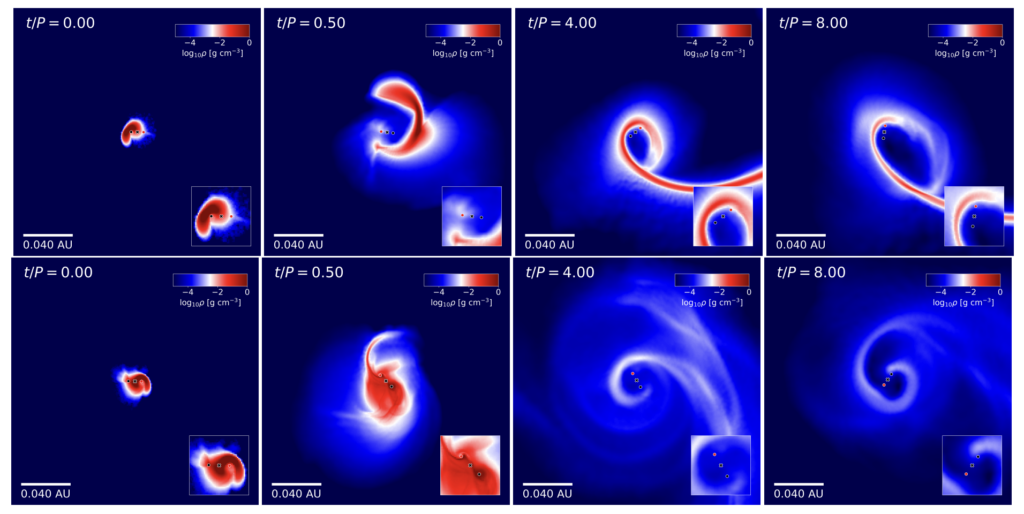
What do the simulations tell us?
The simulation gives changes in the orbital parameters of the binary as an effect of the close encounters. The authors found a change in the orbital separation of the binaries in all of their simulations. Prograde encounters tend to increase the semi-major axis () and make it less compact, whereas retrograde encounters make the binary tighter (
). If the initial binary was in a circular orbit, TDEs could make it eccentric for both prograde and retrograde encounters. However, if the binary had some initial non-zero eccentricity, it increases for retrograde and decreases for prograde TDEs.
The simulations show that the effect of TDEs on the separation and orbital eccentricity of the BBH system is significant. A change in both the separation and orbital eccentricity affects the gravitational wave driven merger time scale of the black hole binary. Merger time scales () for BBH systems studied here are in the range of
years. The authors calculated that TDEs in a prograde encounter increase the merger time scale by a factor up to order unity relative to the initial value (
), whereas retrograde encounters decrease the relative merger time scale by unity.
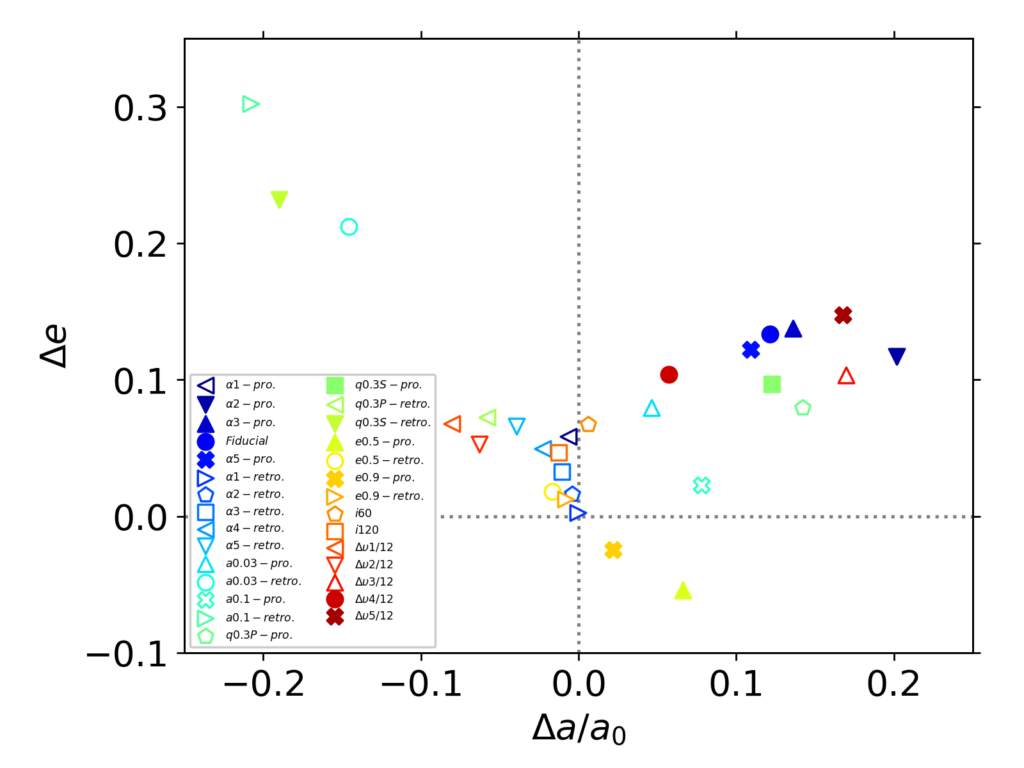
LIGO and Virgo have so far only observed gravitational waves from circular binaries. This is because most binaries have their orbits circularized due to the emission of gravitational radiation. We could detect binaries with some non-zero eccentricity in the future, but how many of them are out there and what are our chances of seeing them? This study shows that TDEs in nuclear and globular clusters act as a vital formation channel for eccentric binaries. Therefore it is important to understand how frequent these TDEs are and their effect on LIGO-Virgo binaries.
TDEs are also one of the few events that might lead to the detection of an electromagnetic (EM) counterpart to BBH mergers. An EM counterpart to a gravitational wave event provides us with a better understanding of the physics of the source. We have previously detected a joint detection of a gravitational wave and EM radiation from the merger of two neutron stars. We expect to see an increase in the number of detectable TDEs with sky surveys like eRosita, the Zwicky Transient Facility (ZTF), and upcoming surveys like the Vera Rubin Observatory (VRO)’s LSST. It would be fascinating to see a TDE detection along with a gravitational wave signal.
Astrobite edited by William Lamb and Katy Proctor
Featured image credit: NASA

